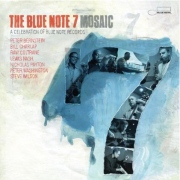 With the temperature dropping, it's time to find someone to keep you warm. Find your hookups with our online dating guide!
With the temperature dropping, it's time to find someone to keep you warm. Find your hookups with our online dating guide!
Mosaic
- Jazz
- 2009
- Buy the CD
Reviewed by Michael Fortes
()
Subtitled “A Celebration of Blue Note Records,” Mosaic finds an all-star collective dubbed the Blue Note 7 covering eight different classic jazz compositions from the days when the label could do no wrong. Or rather, the days during which everyone can agree the label did no wrong, when it had yet to broaden its musical reach to non-jazz areas.
Pianist Bill Charlap leads the group, comprised of Nicholas Payton (trumpet), Ravi Coltrane (tenor sax), Lewis Nash (drums), Peter Bernstein (guitar), Peter Washington (bass) and Steve Wilson (alto sax and flute). Just looking at this lineup on paper (or on screen, as it may be) lends the assumption that, even without the Blue Note label attached to the package, this will be a classy, pristine presentation. And in practice, yes, this is exactly the case. Though he only arranged one tune (Horace Silver’s “The Outlaw” – the rest were arranged by Nash, Payton, Bernstein, Williams, and Charlap’s wife, Canadian pianist Renee Rosnes), this is just what one would expect from an ensemble led by Charlap, and in that regard, he does not disappoint.
Yes, this ensemble does everything right – they respect the original recordings while adding their own stamp to classics like Herbie Hancock’s “Dolphin Dance” and Thelonious Monk’s “Criss Cross.” Charlap’s solo in “The Outlaw” has just the right amount of grit. And Bernstein’s guitar in Duke Pearson’s “Idle Moments” spins the most memorable lines of the album, coming closest to that gut-level feeling that made those old Grant Green records so thrilling.
In a sense, the “museum music” (to cop a phrase from Miles Davis) aspect of Mosaic is entirely appropriate, given the fact that, no matter how successful the likes of Hancock or Bobby Hutcherson were at keeping the genre fresh back in their day, trying to move that jazz spirit forward when those who will likely find this album of interest would want the original Blue Note “sound” intact would be a political firestorm. So in the end, what we get is a more-than-competent recorded tribute that’s both respectful and functional – it effectively serves as a preview of the group’s upcoming tour, which will feature more new arrangements of Blue Note classics. Yet, as tributes go, it’s not terribly original in spite of liberties taken with the arrangements. Even the album’s title was already more prominently used for a landmark Art Blakey record, one that will still sound fresh long after this one’s sell-by date.
You can follow us on Twitter and Facebook for content updates. Also, sign up for our email list for weekly updates and check us out on Google+ as well.











